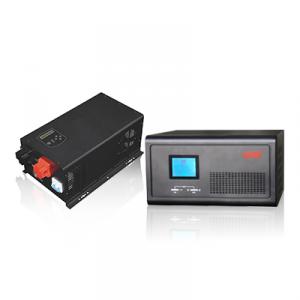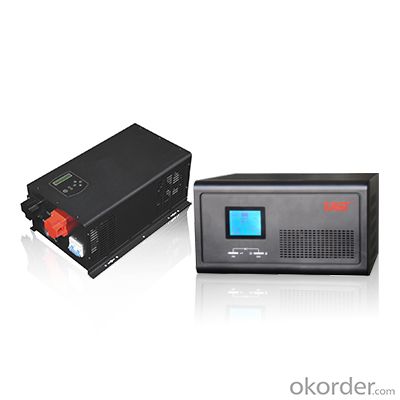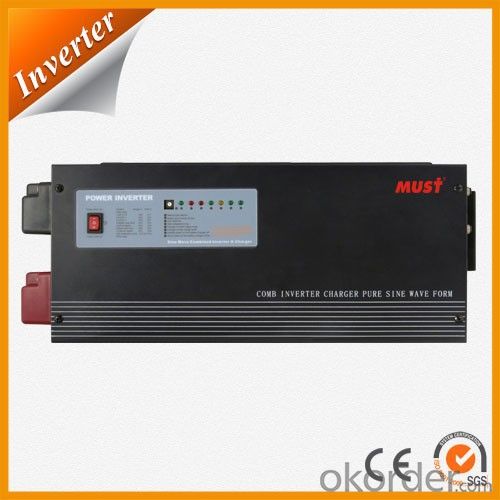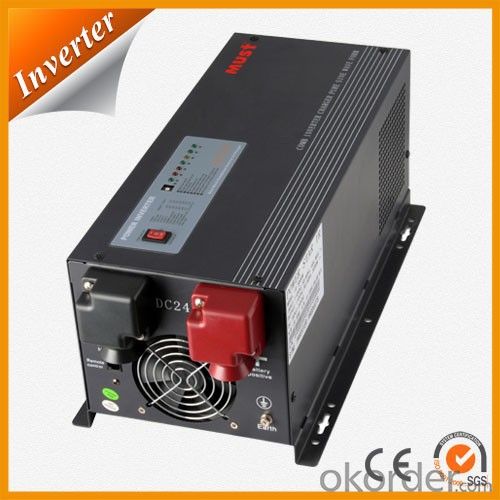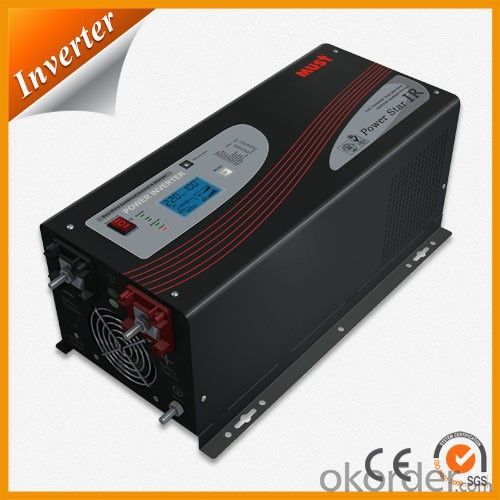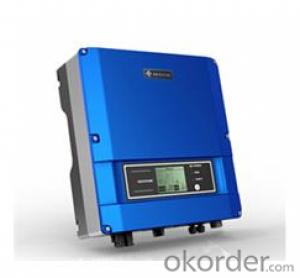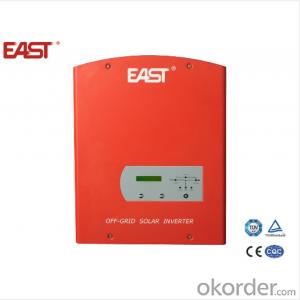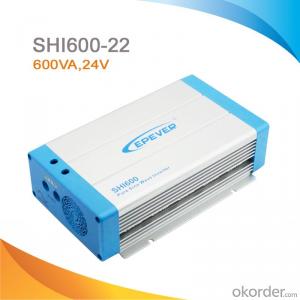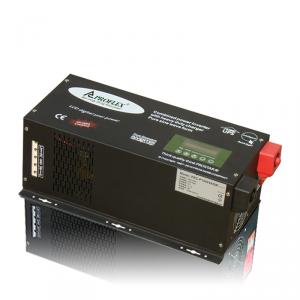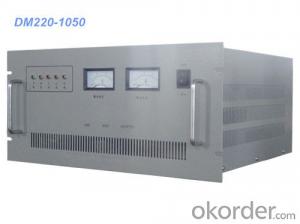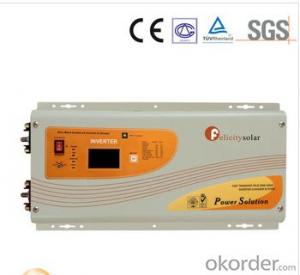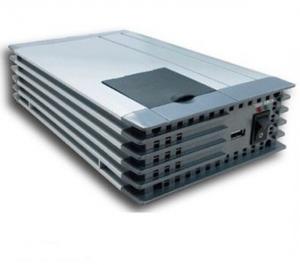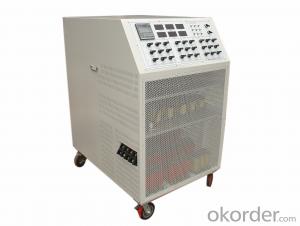5kV Solar Inverter - Pure Sine Wave Inverter Home Inverter 600-3500W
- Loading Port:
- China main port
- Payment Terms:
- TT or LC
- Min Order Qty:
- 100 pc
- Supply Capability:
- 1000 pc/month
OKorder Service Pledge
OKorder Financial Service
You Might Also Like
| Home Inverter 600-3500W |
Home Inverter 600W-3500W is Pure sine wave output inverter which are specially used for house appliance such as TV, refrigerator, fan, air conditioner etc, and also it can be used as UPS for computers. That means It can supply power to various loads such as resitive load, inductive load, motors and rectifier load. It is equipped with programmable big current, 3 stages battery charger (10-70Amp adjustable charger) to run 10hrs longer backup time. |
● Reliable, Durable and Economical Power for Grid and Mobile Applications
● Microprocessor based Inverter / Charger provides
● Ultra-clean pure sine wave output with less than 5% total harmonic distortion
● Supply energy to various loads such as resistive load, inductive load, motors and rectifier load.
● Control panel with large LCD
● Powerful 300% surge power
● Low sleep mode power consumption of less than 5W
● Phase & frequency synchronization auto-tracing for seamless transfer time
● Programmable big current, 3 stages battery charger
● Long backup time up to 10 hours (based on the battery bank and loads).
● Easy to install, easy to maintain, and built for years of reliable service
Q. How long the UPS to run when power goes?
This can take 3 paths.
1.You can pick a UPS that is rated for pretty much the full VA you need so it will be running at 100% of capability and will thus last 'n' minutes.
2.You can pick a UPS that is rated at a much higher VA value than you really need so, for example, is running at 50% of capability and will thus last for longer than the UPS from option 1.
3.You can use extra external battery packs to run for longer. If charging capability allows, the more and the bigger batteries you take with, the longer time UPS runs.
or using a generator after about 6 hours, it will be more cost-effective, with a short runtime UPS to bridge the generator start-up gap.Q. What's lifetime of a UPS ?
Most plug-in UPS are workable for at least five years. We'd advise you to change the batteries every three to four years. For larger equipment, we maintain equipment for twenty years old and still going strong.
Q. How to maintain a UPS ?
There are three simple methods: Never overload your UPS, never connect any home electronic devices such as cooling fan to your UPS. This may cause malfunction of your UPS. Discharge the battery in a consistent interval, once a month or once two months. You can do this by turning on the UPS without connecting the mains.
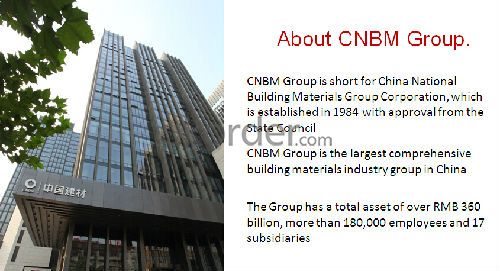
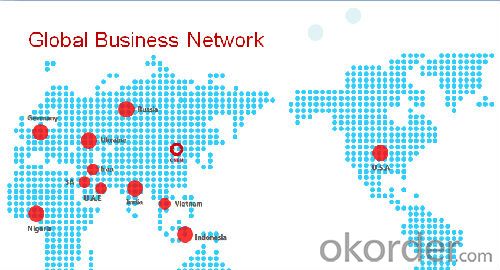
- Q: What is the role of a display interface in a solar inverter?
- The role of a display interface in a solar inverter is to provide real-time information and control options to the user. It allows the user to monitor and understand the performance of the solar inverter, such as the amount of energy being generated, the status of the system, and any potential issues. The display interface also enables the user to adjust and optimize the settings of the inverter, such as voltage and frequency, to ensure efficient operation. Overall, the display interface enhances the user experience by providing visibility and control over the solar inverter's functions.
- Q: Can a solar inverter be used in countries with different electrical standards?
- Yes, a solar inverter can be used in countries with different electrical standards. However, it may require certain modifications or additional equipment to ensure compatibility with the specific electrical standards of that country.
- Q: Can a solar inverter be used with different types of solar panels (monocrystalline, polycrystalline, thin-film)?
- Yes, a solar inverter can be used with different types of solar panels such as monocrystalline, polycrystalline, and thin-film. Solar inverters are designed to convert the direct current (DC) produced by solar panels into alternating current (AC) suitable for use in household or commercial electrical systems. As long as the solar panels generate DC power within the operating range of the inverter, they can be compatible regardless of the technology used.
- Q: Can a solar inverter be used in areas with high altitude and low temperature conditions?
- Areas with high altitude and low temperature conditions can indeed use a solar inverter. However, it is important to take certain factors into account when choosing one for such conditions. The efficiency of a solar inverter can be affected by high altitude, as the reduced air density and oxygen levels can lead to a decrease in power output from the solar panels. Therefore, it is vital to select an inverter that is specifically designed to function at high altitudes. These inverters come equipped with features like advanced cooling systems and improved power electronics to ensure optimal performance in such environments. Similarly, low temperature conditions can also impact the efficiency of a solar inverter. Cold temperatures can negatively affect the internal components of the inverter and overall performance. To overcome this challenge, it is recommended to choose an inverter that is designed to operate in low-temperature environments. These inverters typically include features such as internal heaters and temperature sensors to maintain optimal performance even in freezing temperatures. Furthermore, it is advisable to seek guidance from a professional solar installer or manufacturer who can assist in selecting the most suitable solar inverter for high altitude and low-temperature conditions. They can consider factors like local climate, altitude, and specific installation requirements to ensure that the system is designed to withstand and perform optimally in these demanding conditions.
- Q: How does a solar inverter handle voltage regulation during sudden load changes?
- A solar inverter handles voltage regulation during sudden load changes by continuously monitoring the voltage levels and adjusting the power output accordingly. When there is a sudden increase in load, the inverter will automatically increase its power output to meet the demand and maintain a stable voltage. Conversely, if there is a sudden decrease in load, the inverter will reduce its power output to prevent voltage spikes and maintain a consistent voltage level. This dynamic response allows the solar inverter to effectively regulate voltage during sudden load changes and ensure the stability and reliability of the solar power system.
- Q: Can a solar inverter be monitored remotely?
- Yes, a solar inverter can be monitored remotely. Many modern solar inverters have built-in monitoring capabilities that allow users to track the performance and energy production of their solar system from a remote location. This can be done through software applications or web-based platforms that provide real-time data and analytics, enabling users to monitor the system's efficiency, diagnose issues, and optimize its performance without physically being present at the location of the inverter.
- Q: Can a solar inverter be used in a community solar project?
- Yes, a solar inverter can be used in a community solar project. A solar inverter is an essential component of a community solar project as it converts the direct current (DC) electricity generated by the solar panels into alternating current (AC) electricity, which can be used by the community or fed back into the grid.
- Q: What is the maximum AC output current that a solar inverter can provide?
- The maximum AC output current that a solar inverter can provide depends on its rating, which varies depending on the model and capacity of the inverter.
- Q: Can a solar inverter be used in a solar-powered electric vehicle charging station?
- Yes, a solar inverter can be used in a solar-powered electric vehicle charging station. The solar inverter is responsible for converting the direct current (DC) generated by the solar panels into alternating current (AC) that can be used to charge electric vehicles. This allows the charging station to utilize the solar energy efficiently and power the charging process for electric vehicles.
- Q: What is the maximum efficiency rating of a solar inverter?
- The maximum efficiency rating of a solar inverter can vary, but typically it ranges between 95% and 98%.
Send your message to us
5kV Solar Inverter - Pure Sine Wave Inverter Home Inverter 600-3500W
- Loading Port:
- China main port
- Payment Terms:
- TT or LC
- Min Order Qty:
- 100 pc
- Supply Capability:
- 1000 pc/month
OKorder Service Pledge
OKorder Financial Service
Similar products
Hot products
Hot Searches
Related keywords
